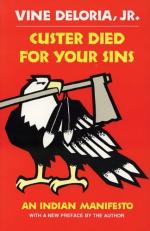
|
| Name: _________________________ | Period: ___________________ |
This test consists of 15 multiple choice questions and 5 short answer questions.
Multiple Choice Questions
1. When the frontier was closed in 1890, what did American enter into next?
(a) The Korean Conflict.
(b) The Civil War.
(c) The Spanish-American War.
(d) WWII.
2. What year did the United States clear the eastern states of the former Indian allies?
(a) 2010.
(b) 1886.
(c) 1934.
(d) 1955.
3. What does the author believe is active in the private sector?
(a) Fairness.
(b) Greed.
(c) Paternalism.
(d) Racism.
4. When Watkins visited the Menominee, what did he compare the living conditions to?
(a) Hiroshima after the atomic bomb.
(b) War torn Italy.
(c) Pearl Harbor after the Japanese attack.
(d) The refugee camps of the Near East after World War II.
5. How do most American Indians feels about taxes?
(a) They feel, like other Americans, that they must pay taxes that are due.
(b) They feel they paid when they gave up two billion acres of land to the U.S.
(c) They pay state taxes, but refuse to pay federal taxes.
(d) They feel they owe taxes.
6. What political aspirations did the Seneca's accuse the government of having regarding the oldest Indian treaty?
(a) The dam was part of the price of keeping Pennsylvania in line for John F. Kennedy at the 1960 Democratic Convention.
(b) Senator Kennedy wanted to buy the land for his own family.
(c) President Kennedy wanted to add the land to Camp David.
(d) President Kennedy needed the land to bargain with the Russians during the Cuban Missile Crisis.
7. By 1943, what was the Senate Interior Committee convinced should happen?
(a) All land should be taken from Indians.
(b) Indians should be compensated for land loss.
(c) Indians should be abolished.
(d) The Indian Bureau should be abolished.
8. What, according to the author, did the white man discover that the American Indians still owned of value?
(a) Gold.
(b) Buffalo.
(c) Horses.
(d) 135 million acres of land.
9. What two tribes seem to have traditional Indian values still intact?
(a) Pueblos of New Mexico and the Apache of the Southwest.
(b) The Apaches of the Southwest and the Northwest Coast Indians.
(c) The Alaskan Inuits and the Pueblos of New Mexico.
(d) The Nez Perce and the Sioux.
10. Why did the Klamath Bill have to be amended?
(a) To prevent them from living in a national park.
(b) To prevent collapse of the lumber industry on the west coast.
(c) To prevent the extinction of salmon.
(d) To prevent tourists from overrunning their fishing areas.
11. What was the Senate Interior Committee afraid of after the passage of the Wheeler-Howard act?
(a) They were afraid of foreign influences.
(b) They were afraid of Indian unity.
(c) They were afraid of the Civil Rights Movement.
(d) They were afraid the French would want the land back.
12. What is the fundamental thesis of the anthropologist?
(a) That people are objects for observation.
(b) That people are human and have a range of emotions.
(c) That people are different and deserve study.
(d) That people are lost in this world and need saving.
13. What was the decision about the Pottawatomie of Kansas during the time of termination?
(a) To move them to Missouri.
(b) To combine them with tribes in Oklahoma.
(c) Better to have them expire as private citizens than let anyone know how badly they had been treated.
(d) To get them better hospitals and roads.
14. How, according to the author, has America always viewed other nations?
(a) America has always honored other nations, but not the Indians.
(b) As neighbors and friends.
(c) As a militantly imperialistic world power eagerly grasping for economic control over weaker nations.
(d) America tries to help other countries, but sometimes oversteps their boundaries.
15. How long did the Indians have under the Wheeler-Howard Act to make a decision about their reservation?
(a) 1 year.
(b) 2 years.
(c) 9 months.
(d) 10 years.
Short Answer Questions
1. What other name is the Wheeler-Howard Act known by?
2. What kind of people do anthropologists believe the Indians are?
3. What year did the Congressional policy of termination begin?
4. What "Civilized" Tribe is among the poorest people in America?
5. What, according to the author, is one of the finest things about being an Indian?
|
This section contains 686 words (approx. 3 pages at 300 words per page) |

|




